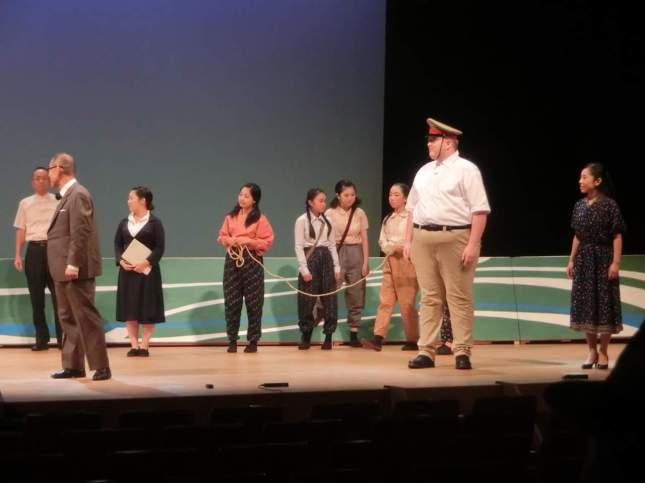「走れ!夢の新幹線 ~キクとシンジの物語~」
(Full speed ahead! The Shinkansen Dream ~The Story of Kiku and Shinji~)
This community musical (hereafter Kiku to Shinji) was the talk of Saijo, our small city in Ehime Prefecture. A collaboration between local residents, the municipal government, and an educational theater group, Kiku to Shinji sold out both its shows, drawing well over 1000 people. In this sense, it was a complete success. More than that, even the toughest local critics were impressed by the quality of the production.
Kiku to Shinji is about Kiku and Shinji Sogo. Shinji (1884-1981) was the 4th Director of Japanese National Railways and a driving force behind the development of the shinkansen bullet train, completed in 1964. The tireless Shinji was supported by his wife Kiku, a music student he met while studying at Tokyo Imperial University. The play covers their life together in flashbacks narrated by the major characters from the corners of the stage, opening and closing with a catchy musical number called “Never give up on your dreams.”
Even locally, some don’t understand the connection between Shinji Sogo and Saijo. After all, the shinkansen doesn’t have service on Shikoku. Shinji was born in Nakahagi, a village in between the present-day cities of Niihama and Saijo. As a boy, he walked four hours to-and-from Saijo for school and later served as Saijo’s mayor for nine months immediately after the end of World War II. (His tenure was abruptly ended, the play explained vaguely, as “part of the occupation army’s strategy.”) This is the basis for Saijo’s claim to his legacy, though Niihamans will dismissively tell you that Nakahagi is part of their city. Building on this connection, Saijo is home to Shikoku’s railway museum (which includes the Shinji Sogo Memorial Museum).

The musical covered Kiku and Shinji’s story in a brisk 80 minutes. It featured a lot of fan service for the hometown crowd, including praise of local food and heartfelt lines about the kindness of the people, as well as an anachronistic reference to a PR slogan created just this year. There were plenty of roles for local kids, including three little ballerinas and a high school dance troupe.
All of these elements created a light atmosphere in spite of the play’s epic historical scope. The musical did spend a long and sober sequence on postwar education reforms, and a scene of teachers explaining why their lessons were wrong and encouraging students to think for themselves reflected current debates about textbooks and teaching history. The audience was gravely quiet during this passage, though the heavy atmosphere soon gave way to an amusing appearance by our own Rowan and a spirited musical number.
As community theater, Kiku to Shinji struck the right balance between drama and comedy. And most importantly, the music was memorable.
Three people gave brief comments after the performance: the playwright, the author of the manga that the musical was based on, and the mayor of Saijo. The mayor called the Kiku to Shinji “Saijo’s treasure” (西条の宝物) and I strongly agreed with him. The palpable effort and enthusiasm of the performers and organizers, and the support of the city’s residents who turned out in droves, created an intense concentration of positive energy that I believe will encourage stronger community spirit and lead to more activities like this.
John is a local JET and friend in Saijo City.





